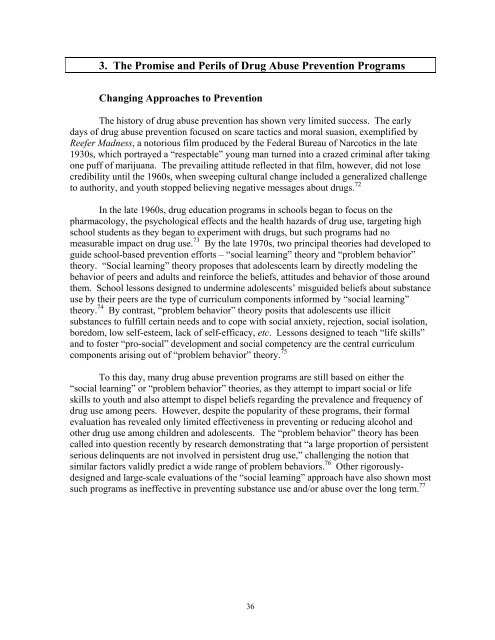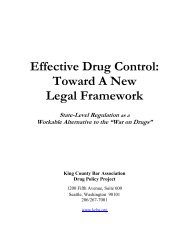Is It Time to End the War on Drugs? - King County Bar Association
Is It Time to End the War on Drugs? - King County Bar Association
Is It Time to End the War on Drugs? - King County Bar Association
You also want an ePaper? Increase the reach of your titles
YUMPU automatically turns print PDFs into web optimized ePapers that Google loves.
3. The Promise and Perils of Drug Abuse Preventi<strong>on</strong> ProgramsChanging Approaches <str<strong>on</strong>g>to</str<strong>on</strong>g> Preventi<strong>on</strong>The his<str<strong>on</strong>g>to</str<strong>on</strong>g>ry of drug abuse preventi<strong>on</strong> has shown very limited success. The earlydays of drug abuse preventi<strong>on</strong> focused <strong>on</strong> scare tactics and moral suasi<strong>on</strong>, exemplified byReefer Madness, a no<str<strong>on</strong>g>to</str<strong>on</strong>g>rious film produced by <str<strong>on</strong>g>the</str<strong>on</strong>g> Federal Bureau of Narcotics in <str<strong>on</strong>g>the</str<strong>on</strong>g> late1930s, which portrayed a “respectable” young man turned in<str<strong>on</strong>g>to</str<strong>on</strong>g> a crazed criminal after taking<strong>on</strong>e puff of marijuana. The prevailing attitude reflected in that film, however, did not losecredibility until <str<strong>on</strong>g>the</str<strong>on</strong>g> 1960s, when sweeping cultural change included a generalized challenge<str<strong>on</strong>g>to</str<strong>on</strong>g> authority, and youth s<str<strong>on</strong>g>to</str<strong>on</strong>g>pped believing negative messages about drugs. 72In <str<strong>on</strong>g>the</str<strong>on</strong>g> late 1960s, drug educati<strong>on</strong> programs in schools began <str<strong>on</strong>g>to</str<strong>on</strong>g> focus <strong>on</strong> <str<strong>on</strong>g>the</str<strong>on</strong>g>pharmacology, <str<strong>on</strong>g>the</str<strong>on</strong>g> psychological effects and <str<strong>on</strong>g>the</str<strong>on</strong>g> health hazards of drug use, targeting highschool students as <str<strong>on</strong>g>the</str<strong>on</strong>g>y began <str<strong>on</strong>g>to</str<strong>on</strong>g> experiment with drugs, but such programs had nomeasurable impact <strong>on</strong> drug use. 73 By <str<strong>on</strong>g>the</str<strong>on</strong>g> late 1970s, two principal <str<strong>on</strong>g>the</str<strong>on</strong>g>ories had developed <str<strong>on</strong>g>to</str<strong>on</strong>g>guide school-based preventi<strong>on</strong> efforts – “social learning” <str<strong>on</strong>g>the</str<strong>on</strong>g>ory and “problem behavior”<str<strong>on</strong>g>the</str<strong>on</strong>g>ory. “Social learning” <str<strong>on</strong>g>the</str<strong>on</strong>g>ory proposes that adolescents learn by directly modeling <str<strong>on</strong>g>the</str<strong>on</strong>g>behavior of peers and adults and reinforce <str<strong>on</strong>g>the</str<strong>on</strong>g> beliefs, attitudes and behavior of those around<str<strong>on</strong>g>the</str<strong>on</strong>g>m. School less<strong>on</strong>s designed <str<strong>on</strong>g>to</str<strong>on</strong>g> undermine adolescents’ misguided beliefs about substanceuse by <str<strong>on</strong>g>the</str<strong>on</strong>g>ir peers are <str<strong>on</strong>g>the</str<strong>on</strong>g> type of curriculum comp<strong>on</strong>ents informed by “social learning”<str<strong>on</strong>g>the</str<strong>on</strong>g>ory. 74 By c<strong>on</strong>trast, “problem behavior” <str<strong>on</strong>g>the</str<strong>on</strong>g>ory posits that adolescents use illicitsubstances <str<strong>on</strong>g>to</str<strong>on</strong>g> fulfill certain needs and <str<strong>on</strong>g>to</str<strong>on</strong>g> cope with social anxiety, rejecti<strong>on</strong>, social isolati<strong>on</strong>,boredom, low self-esteem, lack of self-efficacy, etc. Less<strong>on</strong>s designed <str<strong>on</strong>g>to</str<strong>on</strong>g> teach “life skills”and <str<strong>on</strong>g>to</str<strong>on</strong>g> foster “pro-social” development and social competency are <str<strong>on</strong>g>the</str<strong>on</strong>g> central curriculumcomp<strong>on</strong>ents arising out of “problem behavior” <str<strong>on</strong>g>the</str<strong>on</strong>g>ory. 75To this day, many drug abuse preventi<strong>on</strong> programs are still based <strong>on</strong> ei<str<strong>on</strong>g>the</str<strong>on</strong>g>r <str<strong>on</strong>g>the</str<strong>on</strong>g>“social learning” or “problem behavior” <str<strong>on</strong>g>the</str<strong>on</strong>g>ories, as <str<strong>on</strong>g>the</str<strong>on</strong>g>y attempt <str<strong>on</strong>g>to</str<strong>on</strong>g> impart social or lifeskills <str<strong>on</strong>g>to</str<strong>on</strong>g> youth and also attempt <str<strong>on</strong>g>to</str<strong>on</strong>g> dispel beliefs regarding <str<strong>on</strong>g>the</str<strong>on</strong>g> prevalence and frequency ofdrug use am<strong>on</strong>g peers. However, despite <str<strong>on</strong>g>the</str<strong>on</strong>g> popularity of <str<strong>on</strong>g>the</str<strong>on</strong>g>se programs, <str<strong>on</strong>g>the</str<strong>on</strong>g>ir formalevaluati<strong>on</strong> has revealed <strong>on</strong>ly limited effectiveness in preventing or reducing alcohol ando<str<strong>on</strong>g>the</str<strong>on</strong>g>r drug use am<strong>on</strong>g children and adolescents. The “problem behavior” <str<strong>on</strong>g>the</str<strong>on</strong>g>ory has beencalled in<str<strong>on</strong>g>to</str<strong>on</strong>g> questi<strong>on</strong> recently by research dem<strong>on</strong>strating that “a large proporti<strong>on</strong> of persistentserious delinquents are not involved in persistent drug use,” challenging <str<strong>on</strong>g>the</str<strong>on</strong>g> noti<strong>on</strong> thatsimilar fac<str<strong>on</strong>g>to</str<strong>on</strong>g>rs validly predict a wide range of problem behaviors. 76 O<str<strong>on</strong>g>the</str<strong>on</strong>g>r rigorouslydesignedand large-scale evaluati<strong>on</strong>s of <str<strong>on</strong>g>the</str<strong>on</strong>g> “social learning” approach have also shown mostsuch programs as ineffective in preventing substance use and/or abuse over <str<strong>on</strong>g>the</str<strong>on</strong>g> l<strong>on</strong>g term. 7736
















